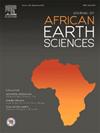Quasi-3D modeling of vertical electrical sounding for mapping hard rock aquifers in the Adamawa Yadé domain, central Africa
IF 2.2
4区 地球科学
Q2 GEOSCIENCES, MULTIDISCIPLINARY
引用次数: 0
Abstract
Exploring water resources in hard rock environments is challenging due to the approach used and the complex weathering processes that control aquifer properties, often leading to inaccurate fracture detection and high borehole failure rates. This study addresses these challenges by applying quasi-3D vertical electrical sounding (VES) techniques to map hard rock aquifers (HRAs) in the Adamawa region of Cameroon, where these aquifers are a critical water source for local communities. Using 28 unevenly distributed VES points, the research developed a quasi-3D model validated against existing borehole data and geoelectric sections. The model revealed key geoelectrical features, including metaconglomerates (1800–2100 Ω m) and a conductive HRA system with resistivity ranging from 500 to 1700 Ω m. This prominent conductive zone identified at depths of 10–40 m suggests the presence of NW-to-NE-oriented dextral strike-slip faults, which facilitate groundwater movement and create horst-and-graben structures. The study also produced a conceptual quasi-3D model illustrating variations in electrical resistivity across the aquifer system, providing a valuable tool for future hydrogeological and geophysical investigations. This model can serve as a guide for managing and protecting the aquifer system from anthropogenic impacts. The findings highlight the usefulness of the quasi-3D VES approach in identifying aquifer systems and fracture patterns in crystalline environments, offering a cost-effective alternative to expensive 3D tools, particularly in low- and middle-income countries. This approach complements traditional 1D VES techniques and demonstrates significant potential for improving groundwater exploration and management in hard rock terrains.
求助全文
约1分钟内获得全文
求助全文
来源期刊

Journal of African Earth Sciences
地学-地球科学综合
CiteScore
4.70
自引率
4.30%
发文量
240
审稿时长
12 months
期刊介绍:
The Journal of African Earth Sciences sees itself as the prime geological journal for all aspects of the Earth Sciences about the African plate. Papers dealing with peripheral areas are welcome if they demonstrate a tight link with Africa.
The Journal publishes high quality, peer-reviewed scientific papers. It is devoted primarily to research papers but short communications relating to new developments of broad interest, reviews and book reviews will also be considered. Papers must have international appeal and should present work of more regional than local significance and dealing with well identified and justified scientific questions. Specialised technical papers, analytical or exploration reports must be avoided. Papers on applied geology should preferably be linked to such core disciplines and must be addressed to a more general geoscientific audience.
 求助内容:
求助内容: 应助结果提醒方式:
应助结果提醒方式:


